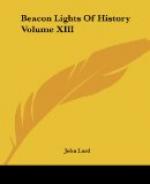unsuccessful, though written, despite Tennyson’s
advanced years, with much fine force and vividness
of character delineation. These dramas (to enumerate
them in their historic order) were “Harold,”
“Becket,” and “Queen Mary.”
“Becket” is the best and most ambitious
of them, though not, as “Queen Mary” is,
a play designed for the stage. It is a vigorous
Englishman’s closet study of a prolonged and
bitter struggle—the conflict in Henry II.’s
time between the church and the crown—as
exhibited in the person and dominant ecclesiastical
attitude of the audacious prelate who met his tragic
end by Canterbury’s altar. “Harold”
strikingly realizes to the modern reader the stirring
activities of a strenuous time,—that of
the English conquest by Norman William, opposed to
the death by Harold at Senlac in 1066. The drama
is as rich in character as it is swift and energetic
in action. “Queen Mary” deals with
the religious and political dissensions (the struggle
between the Papacy and the Reformation) of Mary Tudor’s
era, with her love for and marriage with Philip of
Spain, and her hopeless yearning for an heir to the
double crown of England and Spain. An important
and prized addition to our English literature the drama
undoubtedly is, but it is not more than a careful,
accurate, and elaborate historical study. It
lacks, both in spirit and movement, the characteristics
of the Shakespearian drama. Its characters, however,
are vividly brought out, and its situations are often
picturesque and telling. The personages, moreover,
are wanting in the play of creative effect, and the
incidents lack the stir of inventive resource.
Further, though the story of Mary’s life is
essentially dramatic, and the incidents of her reign
are tragic in the extreme, the poet does not seem
to have extracted from either that which goes to the
making of a great drama. This evidently is the
result of following too faithfully the events of history
and the records of the time, as well as, in some degree,
from want of sympathy, which Tennyson could not impart,
with the leading characters and their actions.
Still, much is made of the materials; and though the
personages and incidents appear in the narrative in
the neutral tints of history, yet the period is made
to reappear with a freshness and distinctness which,
while it satisfies the scholar, gives a true charm
to every lover of the drama. Again and again,
as we read, are we reminded of the Laureate’s
rare poetical fancy and fine literary instinct, and
the dialogues contain many passages of striking thought
and noble utterance. But the work is overcast
by the great gloom of its central figure,—the
gloom of bigotry, passion, jealousy, disappointment,
and despair which ever environs the miserable Queen;
and much though the poet has striven to brighten the
picture and awaken sympathy for the weakness of the
woman, who, royal mistress though she was, could not
command her love to be requited, the poetic measure
of his lines roughens and hardens to the close, when
the curtain falls on what is felt to be a tragic and
unlovely life.




